27 November, 2003
And Waiting….
Our flights are scheduled to start at 2:40 PM today – the fourth day
that we have been waiting to fly to our acclimatization camp on the Fang
Glacier. We had waited all day yesterday only to be cancelled around 4
PM. With so much time to spare, I spent the last two days wandering
around Crary Lab asking a flood of questions about other projects. As a
result, word got out that I wanted to write some journal entries about
other people’s work. Yesterday I was invited to go along with Dr. Art
DeVries’s Antarctic Cod group as a diver tender (a person who helps
transport dive gear and supports the divers from the surface). Sadly, I
wasn’t able to go because Helo-ops hadn’t yet cancelled our flight for
that day. I needed to be here in McMurdo, on standby, in the event that
the weather cleared and we could fly out. But I was thrilled that they
had invited me to go with them! Much to my delight, this morning I met
Phil Forte, one of the divers the Cod Project. He heard that I was
interested in learning about the fish projects and invited me to go out
on the sea ice to pull up a plankton net.
We took one of the awesome McMurdo trucks, which have tracks instead of
tires (Figure 1), out onto the sea ice. Several heated huts are built
around the holes used for the fish projects and we were headed for Hut
#6, which sits on 4.5 meters (15 feet) of sea ice above 400 m (1,300 ft)
of water. The warm hut helps keep the hole open, but upon arrival we
found that it needed a little maintenance. We spent about ten or fifteen
minutes fishing ice cubes off of the surface (Figure 2) and dumping them
into a box in the corner where they melt and the water is funneled back
into the hole. Once we had cleared the bulk of the ice away from the
hole, I could see exactly how thick the sea ice is. The top of the hole
is well lit and you can see the walls extending down about 4.5 m (15
ft), but the open water below the ice appears to be a big, black void.
Peering down the hole, my desire to dive here abated a little bit until
Phil assured me that they actually do their diving in much shallower
water where you can see the bottom. At 400 meters depth, you would have
to be tethered to a safety line. I have a lot of respect for the divers
here as the water is frigid and that big hole in the ice starts to look
awful small when you consider the extent of the solid sea ice
surrounding this one little hole. But the eternally curious side of me
still would jump at the chance to dive here! Under the right conditions,
the visibility can reach up to 243 m (800 ft)! And according to Phil,
when there is less snow cover, sunlight filters down through the ice and
lights the water up. Unbelievable!
After clearing the ice from the hole, Phil fired up the winch and
proceeded to slowly pull up the plankton net (Figure 3), which was our
objective in coming out today. Dr. DeVries’s projects focus on the
Bathyberthella antarctica, or Ice Fish (Figure 4), and Antarctic
Cod (see 11/25/03 Still Waiting), which feed on smaller
organisms. Two days ago a long, cone shaped net with a little
waterbottle sized sieve was dropped to the bottom. Trapped in the lower
net and sieve are plankton and small shrimp and fish. We were pulling up
the net and sieve to collect food for the Ice Fish that are back in the
lab.
As I was peering down the ice hole, still contemplating how great it
must be to dive under the ice, I noticed a dark shape spiraling up
toward the surface (Figure 5). As I squinted a little harder in the dim
light of the hut, the shape took on the distinct form of a Weddell Seal
(Figures 6 and 7)! And just like that I suddenly found myself nose to
nose with a seal, greeted by a big wet puff of seal-breath directly in
my face (Figure 8)!
With the plankton stored away in a cooler, we had a few minutes to watch
these graceful and comic giants (Figures 9-11). They happily utilize the
dive holes as breathing holes and seems quite accustomed to the funny
bipeds scuttling around the hole, snapping photos. In the meantime, the
seals lounged about at the surface, just ducking out of sight each time
I thought I had lined up the perfect photo. Occasionally one seal would
blow at another, attempting to drive the competition away from the hole.
Phil informed me that they had learned to cooperate fairly well by this
point in the season as four seals were occupying this parcticular hole.
Early in the season though, they would compete for the space. My
question is “What happens to the diver who wants to come up through this
hole?” The Weddell seal can grow to over three meters (10 feet) in
length and weigh up to 400 - 450 kilograms. I imagine that one or two of
these fellows present a formidable obstacle for a tired diver trying to
surface.
The Weddell seals themselves are efficient divers, storing a large
amount of oxygen in their blood and muscles enabling them to dive to
depths of 300-400 meters for fifteen minutes. The record dives have been
82 minutes long and extended down to 700 meters. The Weddells establish
breathing holes that allow them to fish under the ice and then haul out
on the ice to rest and rear pups. Weddells maintain these breathing
holes by scraping at the ice edge with their teeth, knocking loose any
new ice. The net result of this activity is severe wear on their canines
and incisors (Figure 12). But the Weddell seal skull is designed for
this purpose, with forward facing incisors that become blunted with use.
With a diet of fish (especially D. mawsoni; See 11/25/03
Still Waiting) and cephalopods (squid and octopus), krill,
isopods, amphipods, and decapods, maintaining sharp canines is not as
critical as it would be if they ate warm-blooded mammals like the
Leopard Seals do.
The Leopard seal is sleeker than the Weddell seal and built for speed,
as it is the only seal that regularly preys on warm- blooded animals.
Leopard seals will eat penguin adults and chicks, birds, and Weddell
seals in addition to cephalopods (squid and octopus), krill, fish, and
crustaceans. Figure 13 illustrates how well adapted Leopard Seals are
for such a diverse diet. Note the large canines and incisors, useful in
snatching and holding a penguin while thrashing it about to remove the
skin. Behind the large canines are smaller, interlocking teeth useful in
straining the krill out of the water. Because Leopard Seal prefer the
pack ice (broken up sea ice), they are found at the edge of the ice
shelf until late summer when the ice breaks up in McMurdo Sound.
All good things must come to an end, and in my case, it was time to head
back to the lab with the fish food. With one final look over its
shoulder (Figure 14), the last remaining seal dove down the hole seeking
a snack while I deliriously floated back to the truck, realizing as I
left that I have never been so close to one of these awesome creatures
before. As I stepped out the door, it dawned on me that my camera takes
mpeg videos! I had completely forgotten this fact while entranced by my
new pinneped friends. Maybe next time….
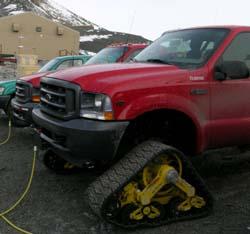
1. Figure 1 – One of the cool looking Antarctic trucks with tracks in lieu of wheels.
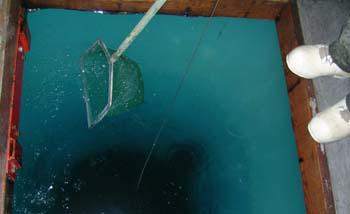
2. Figure 2 – While the heated air in the hut keeps the hole from freezing over entirely, periodic maintenance is required to remove the ice chunks from the surface.
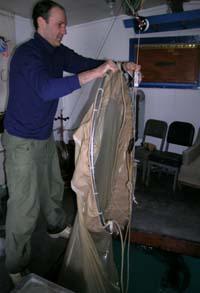
3. Figure 3 – Phil maneuvers the plankton net out of the water. We were collecting fish food (tiny shrimp, amphipods, pteropods (shell-less gastropods), etc.) for the cod and ice fish in the lab.

4. Figure 4 – An ice fish, Bathyberthella antarctica rests on the bottom of its tank. Dr. Art DeVries is examining the antifreeze protein that allows these fish to live in –1.8 degree water. Look carefully at the dark spot in the center of the head, just behind the eyes and you can see its brain visible through the transparent skin.
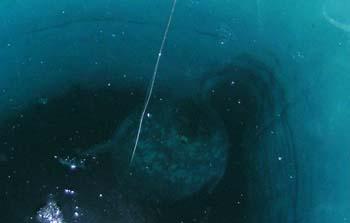
5. Figure 5 – Looking down the ice hole a dark form is visible, spiraling upward at us.

6. Figure 6 – A Weddell seal about to break the surface.
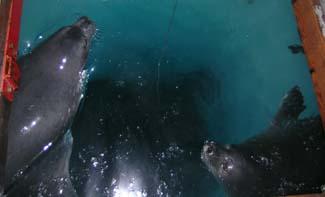
7. Figure 7 – Two Weddell seals pop to the surface of the dive hole like corks.
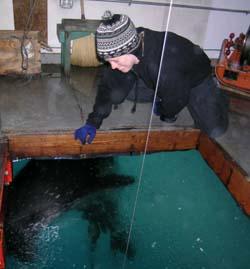
8. Figure 8 – Having bent down for a better look, I am greeted by a loud, wet puff of seal- breath straight in my face before my new friend ducked back under water.

9. Figure 9 – Keeping one wary eye on me and one eye our for competition for space in the hole, this seal lounges about.

10. Figure 10 – Nostrils flared, a Weddell seal takes a deep breath.

11. Figure 11 – Submerging in a sea of ice cubes, one last flare of the nostrils and deep breath will suffice to keep this seal down anywhere from 15 minutes to an hour.
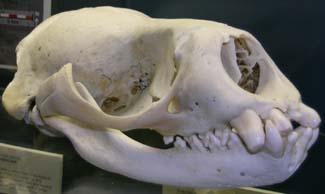
12. Figure 12 – A Weddell seal skull shows incisors that project forward and canines that are well worn from scraping ice to keep a breathing hole open.

13. Figure 13 – A Leopard seal skull exhibits long, sharp canines and incisors used for snatching and holding prey (such as penguins, birds, and Weddell seals) while the seal thrashes it out of its skin. The smaller, interlocking rear molars are useful in straining krill out of the water.
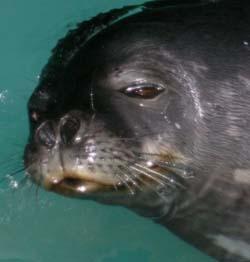
14. Figure 14 – One last look over its shoulder and a Weddell seal submerges in search of a snack.
Contact the TEA in the field at
.
If you cannot connect through your browser, copy the
TEA's e-mail address in the "To:" line of
your favorite e-mail package.
|
